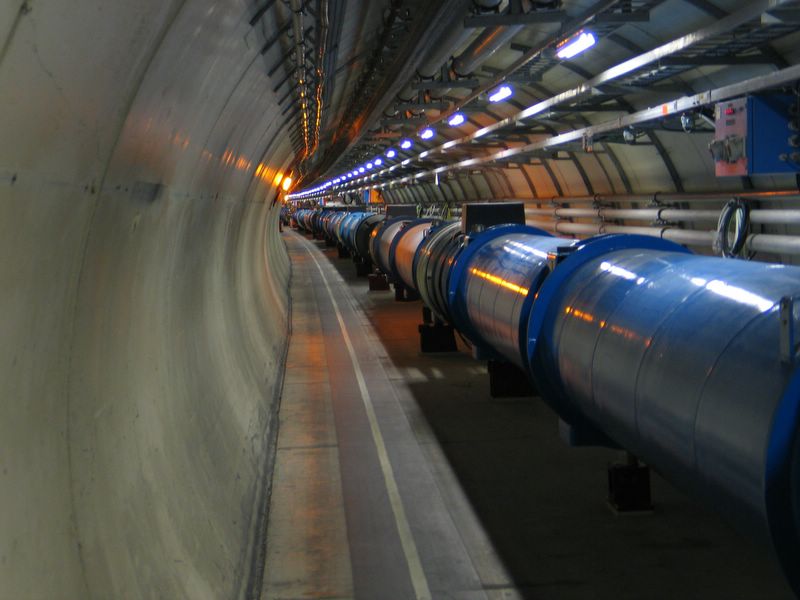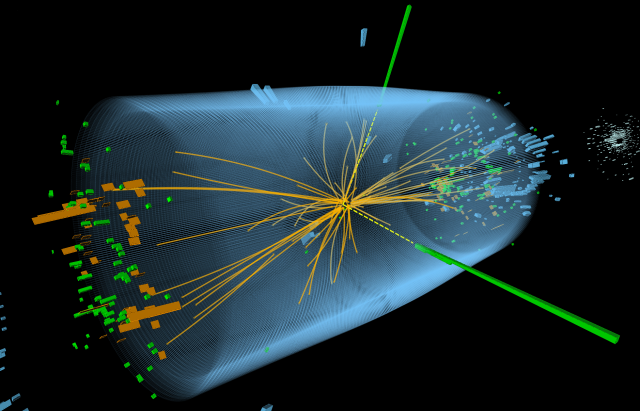Energy Frontier
Image courtesy of CERN.
Particles travel at almost the speed of light through thousands of superconducting magnets in the nearly 17 mile long ring of the Large Hadron Collider (LHC).
Researchers at the Energy Frontier use the world’s largest and highest energy particle accelerator to recreate the universe as it was a billionth of a second after the big bang and make huge discoveries about the smallest pieces of the universe. The discovery of the Higgs boson by the ATLAS and CMS experiments at the Large Hadron Collider in July 2012 was the culmination of a global effort that began in 1964 when François Englert, Peter Higgs, and other theorists proposed it as the final piece to the Standard Model of particle physics. While wildly successful in what it can predict about known particles, the Standard Model is not complete in its description of the universe. Many theoretical models predict additional fundamental particles beyond those in the Standard Model that may be produced in very high energy particle collisions, possible through the transformation of energy to matter as described in Einstein’s famous equation, E=mc2. The Large Hadron Collider may also be able to create dark matter, providing unique insight into its mysterious nature. U.S. Energy Frontier research groups have made leading contributions to both the discovery and the confirmation of the Higgs boson and will continue to play key roles in the future program of discovery at the Large Hadron Collider.
Image courtesy of the CMS Collaboration.
Protons collide inside the ATLAS and CMS detectors, which act like enormous digital cameras that allow researchers to study the smallest pieces of the universe.
Now that the Higgs boson has been discovered, Energy Frontier researchers will use it as a new tool for discovery. The Higgs boson plays a central role in the Standard Model and affects many of its predictions. Some models of new physics predict more than one type of Higgs boson or additional particles that would interact with the Higgs boson. By precisely measuring the Higgs boson’s properties, Energy Frontier researchers will be able to establish its exact character and discover if there are indications of new physics beyond the Standard Model.
Researchers will use the Large Hadron Collider to explore the unknown and search for evidence of new particles and forces beyond the Standard Model. Many models make predictions that can be directly tested or indirectly constrained through the study of high energy particle collisions. One such proposed theory, Supersymmetry, predicts that every particle in the Standard Model has a heavy partner waiting to be discovered by high energy machines, like the Large Hadron Collider. High energy particle collisions also allow researchers to explore mechanisms of black hole production, search for extra dimensions of space, and pursue other exotic phenomena.
It is possible that dark matter particles could be produced at the Large Hadron Collider, allowing researchers to study them as they are made. Dark matter only interacts weakly with normal matter and would itself be invisible to the LHC detectors, but Energy Frontier researchers could measure its general properties through inference by understanding the behavior of the ordinary matter produced at the same time. Detecting the production of dark matter at a particle collider complements, and is a powerful cross-check on, the ultra-sensitive direct detection experiments at the Cosmic Frontier that rely on observing naturally produced dark matter. Limits on dark matter production set by the Large Hadron Collider experiments already significantly constrain many theoretical models.
The Energy Frontier supports fabrication projects and operates experiments that further the science and enable discovery. The High Energy Physics Advisory Panel (HEPAP) advises the DOE on Energy Frontier program status and direction.






